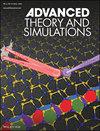聚合物的堆积和抛射动力学:约束、聚合物刚度和活性的作用
IF 2.9
4区 工程技术
Q1 MULTIDISCIPLINARY SCIENCES
引用次数: 0
摘要
生物聚合物的易位,如DNA和蛋白质,跨越细胞膜或核膜是许多生物过程所必需的。易位动力学受到聚合物性质的影响,如聚合物刚度和衣壳的几何形状。本研究旨在研究聚合物刚度、活性和不同衣壳几何形状对被动和活性聚合物的充填和喷射动力学的影响。采用朗格万动力学模拟进行了系统的研究。可以观察到,柔性聚合物的包装时间比半柔性聚合物的包装时间要快。有趣的是,与衣壳大小相比,对于大的聚合物,与椭球体相比,球体有助于更快的包装和解包装,模拟细胞核,并表明生物聚合物易位的几何优势。总之,我们观察到活性的增加加速了柔性和半柔性聚合物的填充和喷射过程。然而,对于半柔性聚合物,这种效应更为明显,突出了聚合物柔韧性在这些动力学中的关键作用。这些发现加深了对聚合物柔韧性、衣壳几何形状和活性之间复杂相互作用的理解,为聚合物充填和喷射过程的动力学提供了有价值的见解。本文章由计算机程序翻译,如有差异,请以英文原文为准。
Packing and Ejection Dynamics of Polymers: Role of Confinement, Polymer Stiffness, and Activity
The translocation of biopolymers, such as DNA and proteins, across cellular or nuclear membranes is essential for numerous biological processes. The translocation dynamics are influenced by the properties of the polymers, such as polymer stiffness, and the geometry of the capsid. This study aims to investigate the impact of polymer stiffness, activity, and different capsid geometries on the packing and ejection dynamics of both passive and active polymers. Langevin dynamics simulations are employed for a systematic investigation. It is observed that flexible polymers exhibit packing times that are faster than those of their semi‐flexible counterparts. Interestingly, for large polymers compared to the capsid size, sphere facilitates faster packing, and unpacking compared to ellipsoid, mimicking the cell nucleus and suggesting a geometrical advantage for biopolymer translocation. In summary, it is observed that increasing activity accelerates both the packing and ejection processes for both flexible and semi‐flexible polymers. However, the effect is significantly more pronounced for semi‐flexible polymers, highlighting the crucial role of polymer flexibility in these dynamics. These findings deepen the understanding of the intricate interplay between polymer flexibility, capsid geometry, and activity, providing valuable insight into the dynamics of polymer packing and ejection processes.
求助全文
通过发布文献求助,成功后即可免费获取论文全文。
去求助
来源期刊

Advanced Theory and Simulations
Multidisciplinary-Multidisciplinary
CiteScore
5.50
自引率
3.00%
发文量
221
期刊介绍:
Advanced Theory and Simulations is an interdisciplinary, international, English-language journal that publishes high-quality scientific results focusing on the development and application of theoretical methods, modeling and simulation approaches in all natural science and medicine areas, including:
materials, chemistry, condensed matter physics
engineering, energy
life science, biology, medicine
atmospheric/environmental science, climate science
planetary science, astronomy, cosmology
method development, numerical methods, statistics
 求助内容:
求助内容: 应助结果提醒方式:
应助结果提醒方式:


